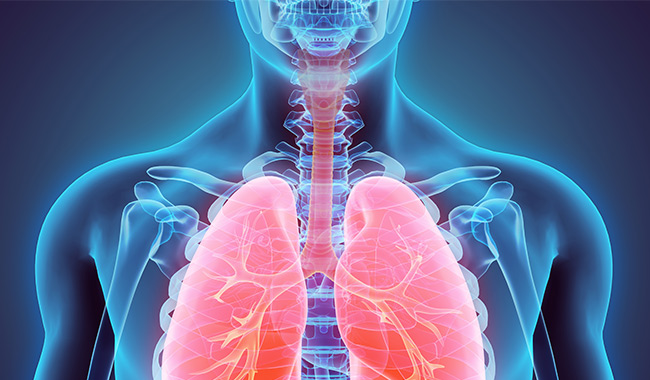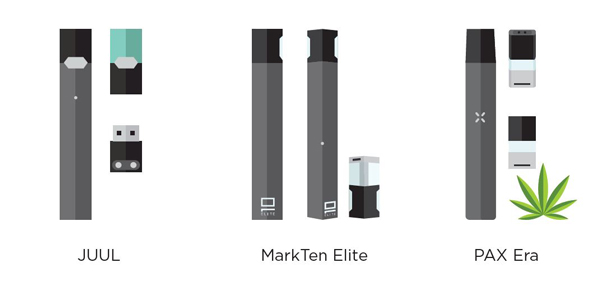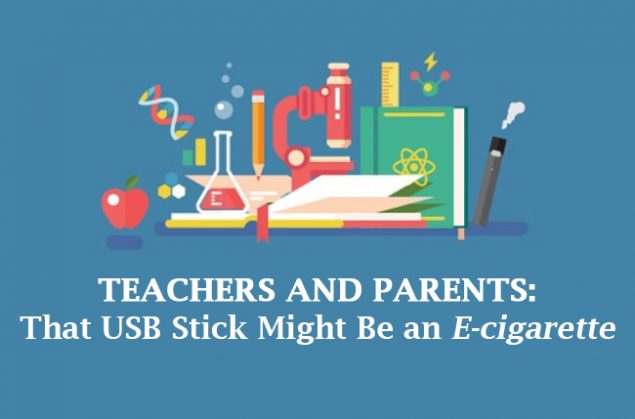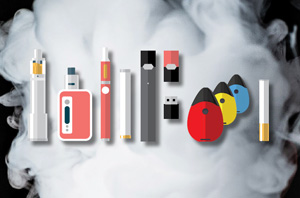Quick Facts on the Risks of E-cigarettes for Kids, Teens, and Young Adults
What’s the Bottom Line on the Risks of E-cigarettes for Kids, Teens, and Young Adults?
- The use of e-cigarettes is unsafe for kids, teens, and young adults.
- Most e-cigarettes contain nicotine. Nicotine is highly addictive and can harm adolescent brain development, which continues into the early to mid-20s.1
- E-cigarettes can contain other harmful substances besides nicotine.
- Young people who use e-cigarettes may be more likely to smoke cigarettes in the future.

The use of e-cigarettes is unsafe for kids, teens, and young adults.
What Are E-cigarettes?
- E-cigarettes are electronic devices that heat a liquid and produce an aerosol, or mix of small particles in the air.
- E-cigarettes come in many shapes and sizes. Most have a battery, a heating element, and a place to hold a liquid.
- Some e-cigarettes look like regular cigarettes, cigars, or pipes. Some look like USB flash drives, pens, and other everyday items. Larger devices such as tank systems, or “mods,” do not look like other tobacco products.
- E-cigarettes are known by many different names. They are sometimes called “e-cigs,” “e-hookahs,” “mods,” “vape pens,” “vapes,” “tank systems,” and “electronic nicotine delivery systems (ENDS).”
- Using an e-cigarette is sometimes called “vaping.”

Some e-cigarettes look like regular cigarettes, cigars, or pipes.
Some look like USB flash drives, pens, and other everyday items.
On This Page
- What Are E-cigarettes?
- How Do E-cigarettes Work?
- What Is JUUL?
- Why Is Nicotine Unsafe for Kids, Teens, and Young Adults?
- What Are the Other Risks of E-cigarettes for Kids, Teens, and Young Adults?
- What Is in E-cigarette Aerosol?
- Flavors and Marketing Make E-cigarettes Appealing to Youth
- Can Using E-cigarettes Lead to Future Cigarette Smoking Among Kids, Teens, and Young Adults?
- Aren’t E-cigarettes Safer Than Cigarettes?
- Are E-cigarettes Regulated at the Federal Level?
- Are There Any National Public Education Prevention Campaigns Focused on Youth and E-cigarettes?
- What Do We Know About Heated Tobacco Products?
- What Can I Do to Prevent My Child from Using E-cigarettes or to Help Them Stop?
- Where Can I Learn More?
- Resources
- Multimedia about E-cigarettes
- Sources
How Do E-cigarettes Work?
- E-cigarettes produce an aerosol by heating a liquid that usually contains nicotine, flavorings, and other chemicals that help to make the aerosol.
- The liquid used in e-cigarettes often contains nicotine and flavorings. This liquid is sometimes called “e-juice,” “e-liquid,” “vape juice,” or “vape liquid.”
- Users inhale e-cigarette aerosol into their lungs. Bystanders can also breathe in this aerosol when the user exhales it into the air.
- E-cigarette devices can be used to deliver marijuana and other drugs.
What Is JUUL?

News outlets and social media sites report widespread use of JUUL by students in schools, including classrooms and bathrooms.
- JUUL is a brand of e-cigarette that is shaped like a USB flash drive. Like other e-cigarettes, JUUL is a battery-powered device that heats a nicotine-containing liquid to produce an aerosol that is inhaled.
- All JUUL e-cigarettes have a high level of nicotine. According to the manufacturer, a single JUUL pod contains as much nicotine as a pack of 20 regular cigarettes.2
- JUUL is one of a few e-cigarettes that use nicotine salts, which allow particularly high levels of nicotine to be inhaled more easily and with less irritation than the free-base nicotine that has traditionally been used in tobacco products, including e-cigarettes.
- News outlets and social media sites report widespread use of JUUL by students in schools, including classrooms and bathrooms.
- Approximately two-thirds of JUUL users aged 15 – 24 do not know that JUUL always contains nicotine.
- Although JUUL is currently the top-selling e-cigarette brand in the United States, other companies sell e-cigarettes that look like USB flash drives. Examples include the MarkTen Elite, a nicotine delivery device, and the PAX Era, a marijuana delivery device that looks like JUUL.
- Additional information about USB-shaped e-cigarettes and actions that parents, educators, and health care providers can take to protect kids is available at CDC’s Infographicpdf icon [PDF – 1.2MB]
Why Is Nicotine Unsafe for Kids, Teens, and Young Adults?
- Most e-cigarettes contain nicotine—the addictive drug in regular cigarettes, cigars, and other tobacco products.
- A recent CDC study found that 99% of the e-cigarettes sold in assessed venues in the United States contained nicotine.
- Some e-cigarette labels do not disclose that they contain nicotine, and some e-cigarettes marketed as containing 0% nicotine have been found to contain nicotine.
- Nicotine can harm the developing adolescent brain.1 The brain keeps developing until about age 25.
- Using nicotine in adolescence can harm the parts of the brain that control attention, learning, mood, and impulse control.1
- Each time a new memory is created or a new skill is learned, stronger connections – or synapses – are built between brain cells. Young people’s brains build synapses faster than adult brains. Nicotine changes the way these synapses are formed.
- Using nicotine in adolescence may also increase risk for future addiction to other drugs.1
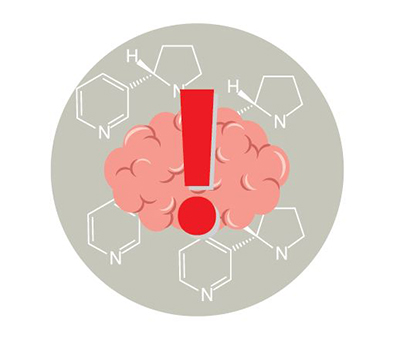
What Are the Other Risks of E-cigarettes for Kids, Teens, and Young Adults?
- Scientists are still learning about the long-term health effects of e-cigarettes.
- Some of the ingredients in e-cigarette aerosol could also be harmful to the lungs in the long-term. For example, some e-cigarette flavorings may be safe to eat but not to inhale because the gut can process more substances than the lungs.1
- Defective e-cigarette batteries have caused some fires and explosions, a few of which have resulted in serious injuries.
- Children and adults have been poisoned by swallowing, breathing, or absorbing e-cigarette liquid through their skin or eyes. Nationally, approximately 50% of calls to poison control centers for e-cigarettes are for kids 5 years of age or younger.
What Is in E-cigarette Aerosol?
- E-cigarette aerosol is NOT harmless “water vapor.”
- The e-cigarette aerosol that users breathe from the device and exhale can contain harmful and potentially harmful substances, including:
- Nicotine
- Ultrafine particles that can be inhaled deep into the lungs
- Flavorings such as diacetyl, a chemical linked to a serious lung disease
- Volatile organic compounds
- Cancer-causing chemicals
- Heavy metals such as nickel, tin, and lead1
- The aerosol that users inhale and exhale from e-cigarettes can expose both themselves and bystanders to harmful substances.
- It is difficult for consumers to know what e-cigarette products contain. For example, some e-cigarettes marketed as containing zero percent nicotine have been found to contain nicotine.3
Flavors and Marketing Make E-cigarettes Appealing to Youth
- E-cigarettes come in various flavors, including fruit, candy, mint, and menthol.
- A study from 2013-2014 showed that most youth who use e-cigarettes first start with a flavored variety, and flavors are the primary reason youth report using e-cigarettes.6
- In 2020, most youth who reported using e-cigarettes used flavored varieties (82.9%).5 Among high school students who currently used any type of flavored e-cigarettes in 2020, the most commonly used flavors are fruit (73.1%), mint (55.8%), menthol (37.0%), and candy, desserts, or other sweets (36.4%).5
- On January 2, 2020, the U.S. Food and Drug Administration (FDA) finalized an enforcement policy that prohibits the sale of prefilled cartridge e-cigarettes in any flavor other than tobacco or menthol, unless authorized by FDA. FDA has since taken additional steps to prohibit certain companies from selling youth-appealing, flavored disposable e-cigarettes and flavored e-liquids without authorization.7
- Several states and communities have restricted the sale of flavored tobacco products, including menthol-flavored products.8
- E-cigarettes are also advertised using the same themes and tactics that have been shown to increase youth initiation of other tobacco products, including cigarettes. In 2016, about 7 in 10 middle school and high school students (69.3%)—more than 18 million youth—said they had seen e-cigarette advertising.9
- Widespread advertising for e-cigarettes, including via media for which advertising for conventional tobacco products is prohibited (e.g., TV), and the lower costs of some e-cigarettes relative to regular cigarettes has contributed to use among youth.1
- Many youth also report using e-cigarettes because they are curious about these products.1
Can Using E-cigarettes Lead to Future Cigarette Smoking Among Kids, Teens, and Young Adults?
- Many young people who use e-cigarettes also smoke cigarettes.1 There is some evidence that young people who use e-cigarettes may be more likely to smoke cigarettes in the future.
- Specifically, a 2018 National Academy of Medicine report found that there was some evidence that e-cigarette use increases the frequency and amount of cigarette smoking in the future.4
- E-cigarettes also can be used to deliver other drugs, including marijuana; in 2016, approximately one-third of U.S. middle and high school students who have ever used an e-cigarette reported using marijuana in the device.
- But e-cigarette use among young people is still unsafe, even if they do not progress to future cigarette smoking.
Aren’t E-cigarettes Safer Than Cigarettes?
- E-cigarettes expose users to fewer harmful chemicals than burned cigarettes.1
- But burned cigarettes are very dangerous, killing half of all people who smoke long-term.
- The use of any tobacco product, including e-cigarettes, is unsafe for young people.
Are E-cigarettes Regulated at the Federal Level?
- Yes. In August 2016, the regulatory authority of the FDA was extended to cover e-cigarettes through the agency’s “deeming rule.”
- Through authority granted by the Family Smoking Prevention and Tobacco Control Act (FSPTCA), FDA has authority to develop regulations that address the manufacturing, marketing, and sale of e-cigarettes.
- There are some strategies that the FDA does not have authority to implement, such as including e-cigarettes in smoke-free policies or increasing the minimum legal sales age for these products, unless directed to do so by Congress. However, the FSPTCA does not prevent states and communities from including e-cigarettes in smoke-free policies or from regulating the sale and distribution of e-cigarettes. These types of strategies can include further raising the minimum legal sales age, licensing retailers, implementing price policies, and restricting or prohibiting the sale of tobacco products.
Are There Any National Public Education Prevention Campaigns Focused on Youth and E-cigarettes?
- Yes. In 2018, the FDA expanded its successful youth tobacco prevention campaignexternal icon, “The Real Cost,” to reach the more than 10 million youth aged 12–17 who have used e-cigarettes or are open to trying them. The campaign educates youth about the potential risks of using e-cigarettes.
- The “Real Cost” reaches teens where they spend most of their time: in school and online. The campaign is also placing e-cigarette prevention materials in high schools across the nation, both in school bathrooms and on educational digital platforms accessed by students during the school day.
- The Truth Initiative® launched the “Safer ≠ Safe” campaign in 2018, focusing on correcting youth misperceptions and providing accurate information about e-cigarettes and youth. The campaign is being promoted on digital and social media, including the Safer ≠ Safe websiteexternal icon, which features videos, articles and interactive activities for youth.
What Do We Know About Heated Tobacco Products?
- Heated tobacco products (HTPs) like IQOS and Eclipse, sometimes marketed as “heat-not-burn” technology, represent a diverse class of products that heat the tobacco leaf to produce an inhaled aerosol. They are different from e-cigarettes, which heat a liquid that can contain nicotine derived from tobacco.
- HTPs are available in at least 40 countries and several have been authorized for sale in the United States by the FDA. In 2018, few U.S. adults (2.4% of all surveyed, including 6.7% of people who currently smoke surveyed) had ever used HTPs. In 2020, 1.4% of U.S. middle and high school students , combined, reported having used heated tobacco products in the past 30 days.9
- Scientists are still learning about the short-term and long-term health effects of HTPs, but the available science shows they contain harmful and potentially harmful ingredients. Youth use of any tobacco products, including heated products, is unsafe.
- It is important that we continue to modernize proven tobacco prevention and control strategies to include newer products entering the market such as HTPs.
What Can I Do to Prevent My Child from Using E-cigarettes or to Help Them Stop?

Talk to your child or teen about why e-cigarettes are harmful for them. It’s never too late.
- Set a good example by being tobacco-free and ensure that your kid is not exposed to the secondhand emissions from any tobacco products, including e-cigarettes.
- If you use tobacco, it’s never too late to quit. For free help, visit smokefree.govexternal icon or call 1-800-QUIT-NOW.
- Talk to your child or teen about why e-cigarettes are harmful for them. It’s never too late.
- Get the Talk With Your Teen About E-cigarettespdf iconexternal icon [PDF – 5.2MB] tip sheet for parents. Start the conversation early with children about why e-cigarettes are harmful for them.
- Let your child know that you want them to stay away from all tobacco products, including e-cigarettes, because they are not safe for them. Seek help and get involved.
- Set up an appointment with your child’s health care provider so that they can hear from a medical professional about the health risks of tobacco products, including e-cigarettes.
- Speak with your child’s teacher and school administrator about enforcement of tobacco-free school grounds policies and tobacco prevention curriculum.
- Encourage your child to learn the facts and get tips for quitting tobacco products at Teen.smokefree.govexternal icon.
Where Can I Learn More?
- E-cigarettes and Youth: Toolkit for Partners pdf icon[PDF–13 MB]
- Surgeon General’s Advisory on E-cigarette Use Among Youth
- SAMHSA—Understanding Addictionexternal icon
- Anyone can experience addiction. Learn the common signs of addiction at the SAMHSA website.
- E-cigarettes Shaped Like Flash Drives: Information for Parents, Educators, and Health Care Providers
- Teachers and Parents: That USB Stick Might Be an E-cigarette
- E-cigarettes.surgeongeneral.govexternal icon
- Information from the Surgeon General on the risks of e-cigarettes for young people, and includes free tools such as a parent tip sheet for talking to teens about e-cigarettespdf iconexternal icon [PDF – 5.2MB].
- Teen.smokefree.govexternal icon
- Information to help teens who want to quit using e-cigarettes.
- Truth Initiative’s This is Quitting Programexternal icon
- This free mobile program is designed to help young people quit e-cigarettes. Resources are available for teens and young adults as well as parents.
- Find Treatmentexternal icon
- Find a list of addiction treatment centers using the SAMHSA website. Please contact a center directly to ask if they treat e-cigarette dependence.
- Electronic Cigarettes
- Basic information about e-cigarettes from CDC’s Office on Smoking and Health.
- CATCH My Breathexternal icon
- Stanford University Tobacco Prevention Toolkitexternal icon
- Substance Abuse and Mental Health Services Administration Reducing Vaping Among Youth and Young Adults Guideexternal icon
- Policy Playbook for E-cigarettes pdf icon[PDF – 12 MB]external icon
- This resource provides policy and advocacy tools for communities, public health practitioners, educators, and others to help address youth e-cigarette use

Fact Sheet for Parents
Download the PDF pdf icon[PDF – 1 MB]
or order a free hard copy

Fact Sheet for Health Care Providers
Download the PDF pdf icon[PDF – 975 KB]
or order a free hard copy

Fact Sheet for Educators
Download the PDF pdf icon[PDF – 614 KB]
or order a free hard copy
Sources
- US Department of Health and Human Services. E-cigarette Use Among Youth and Young Adults: A Report of the Surgeon Generalpdf icon [PDF – 8.47MB]. Atlanta, GA: US Department of Health and Human Services, CDC; 2016. Accessed July 27, 2018.
- Willett JG, Bennett M, Hair EC, et al Recognition, use and perceptions of JUUL among youth and young adults. Tobacco Control Published Online First: 18 April 2018. doi: 10.1136/tobaccocontrol-2018-054273
- Goniewicz ML, Gupta R, Lee YH, et al. Nicotine levels in electronic cigarette refill solutions: a comparative analysis of products from the United States, Korea, and Poland. Int J Drug Policy. 2015;26(6):583–588.
- National Academies of Sciences, Engineering, and Medicine. 2018. Public health consequences of e-cigarettesexternal icon. Washington, DC: The National Academies Press.
- Wang TW, Neff LJ, Park-Lee E, et al. E-cigarette Use Among Middle and High School Students — United States, 2020. Morbidity and Mortality Weekly Report, 2020;69.
- Ambrose BK, Day HR, Rostron B, et al. Flavored Tobacco Product Use Among US Youth Aged 12-17 Years, 2013-2014. JAMA. 2015;314(17):1871-1873. doi:10.1001/jama.2015.13802
- https://www.fda.gov/news-events/press-announcements/fda-finalizes-enforcement-policy-unauthorized-flavored-cartridge-based-e-cigarettes-appeal-childrenexternal icon
- https://www.tobaccofreekids.org/assets/factsheets/0398.pdfpdf iconexternal icon [PDF – 223KB] Wang TW, Gentzke AS, Creamer MR, et al. Tobacco Product Use and Associated Factors Among Middle and High School Students — United States, 2019external icon.. MMWR Surveill Summ 2019;68(No. SS-12):1–22.
- Gentzke AS, Wang TW, Jamal A, Park-Lee E, Ren C et al. Tobacco Product Use Among Middle and High School Students, United States, 2020. Morbidity and Mortality Weekly Report 2020;69(50);1881–1888 [accessed 2020 Dec 17].
Page last reviewed: December 16, 2020
